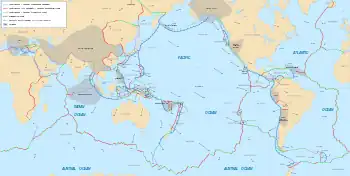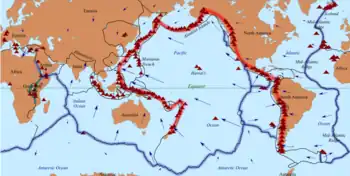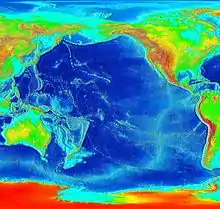
The Pacific Ocean evolved in the Mesozoic from the Panthalassic Ocean, which had formed when Rodinia rifted apart around 750 Ma. The first ocean floor which is part of the current Pacific Plate began 160 Ma to the west of the central Pacific and subsequently developed into the largest oceanic plate on Earth.[1]
The East Pacific Rise near Easter Island is the fastest spreading mid-ocean ridge, with a spreading rate of over 15 cm/yr.[2] The Pacific Plate moves generally towards the northwest at between 7 and 11 cm/yr while the Juan De Fuca Plate has an east-northeasterly movement of some 4 cm/yr.[3]
Most subduction zones around the rim of the Pacific are directed away from a large area in the southern Pacific. At the core–mantle boundary below this area there is a large low-shear velocity province (LLSVP). Most of Pacific hotspots are located above the LLSVP while the longest Pacific hotspot tracks are located at or near its boundaries pointing at the positions of large igneous provinces.[4]
Charles Darwin proposed a theory that explained the existence of reefs by means of slow subsidence of the ocean floor. His theories have been verified and expanded in the development of plate tectonics.[5]
History

In the Early Jurassic, the supercontinent Pangaea was surrounded by the superocean Panthalassa, the ocean floor of which was composed of the Izanagi, Farallon, and Phoenix plates.[6] These three plates were joined at a migrating, or unstable, ridge-ridge-ridge (RRR) triple junction from which the Pacific Plate began to grow 190 million years ago in an area east of the Mariana Trench; this area, known as the Pacific Triangle, is the oldest part of the Pacific Plate and therefore the oldest ocean floor of the Pacific. Spreading laterally from this triangle are the Hawaiian, Japanese, and Phoenix magnetic lineations, the earliest traces of how the Pacific Plate began to grow as a RRR triple junction fell apart into three triple junctions. Virtually all of the three Panthalassic plates have now been subducted beneath surrounding continents but their spreading rates have been preserved in the magnetic lineations around the Pacific Triangle.[7]
In the North Pacific, magnetic anomalies south of the Aleutian Islands indicate the presence of a now almost completely subducted tectonic plate, known as the Kula Plate, which probably existed from the Late Cretaceous to the Eocene (c. 83–40 Ma). This plate probably broke off the Farallon Plate and, when subduction in the North Pacific shifted from Siberia to the Aleutian Trench c. 50 Ma, spreading ceased between the Kula plate and the Pacific Plate.[8]
The Pacific Plate kept growing and lineations south of the Pacific Triangle indicate the Pacific-Phoenix ridge remained a simple N–S trending spreading system 156–120 Ma. Following the formation and break-up of the Ontong Java-Hikurangi-Manihiki large igneous province 120 Ma, however, the Phoenix Plate broke into several smaller tectonic plates. The complexity of the Mid-Pacific and Magellan lineations indicate the presence of a series of microplates around the Pacific-Phoenix-Farallon triple junction.[9]
The Farallon Plate subducted under North America from the late Mesozoic, while spreading between the Pacific and Farallon plates was initiated 190 Ma and lasted until the break-up of the Farallon Plate 23 Ma. During the Cenozoic the Farallon Plate broke-up along the eastern Pacific margin into the Kula, Vancouver/Juan de Fuca, and Cocos plates.[10]
Geological origins of the Pacific islands
The islands of the Pacific have developed in a number of ways. Some have originated as chains of volcanic islands on the tectonic plates either as a result of mantle plumes or by fracture propagation. Atolls have developed in tropical waters when, after volcanoes sink, coral growth results in reefs as evidenced by the Cook Islands. Coral reefs can develop into islands over a submerged extinct volcano following uplift as in Makatea and Rennell Island in the Solomon Archipelago which have steep coral cliffs over 100 metres high.[11]
The Pacific Plate emigrates northeast towards extensive subduction trenches. South of Japan, the Izu-Bonin and Mariana island arcs (IBM) formed in front of a clockwise rotating Philippine Sea Plate. The IBM trenches began to grow in length c. 40 million years ago, opening back-arc basins in the Philippine Sea. Between 30 and 17 Mya, the old age of the subducting Pacific Ocean floor (110-130 Ma) resulted in a very fast trench migration and new back-arc basins opening behind the trenches.[12]
The ocean floor of the Pacific Ocean is composed of nine oceanic tectonic plates, all located in the southeast where the East Pacific Rise separates the Pacific Plate from the Antarctic, Juan Fernández, Nasca, Easter, Galápagos, Cocos, Rivera, Juan de Fuca plates.[13] In the western and southwestern Pacific continental blocks and back-arc basins form one of the most complex regions on earth stretching from Japan to New Zealand.[14]
Plate movements have also caused fragments of continental crust to be rotated away from landmasses so as to form islands. Zealandia which broke off from Gondwana 70 million years ago with the spreading of the Tasman Sea, has since resulted in island protrusions such as New Zealand and New Caledonia. Related causes of island formation include obduction and subduction at convergent plate boundaries. Malaita and Ulawa in the Solomon Islands are the result of obduction while the effects of subduction can be seen in the formation of volcanic island arcs such as the Aleutian Arc off Alaska and the Kermadec-Tonga Subduction Zone north of New Zealand.[11]
Andesite line
Along the rim of the Pacific Basin are convergent plate boundaries often referred to as the andesite line since orogenic andesite is associated with this boundary. This line is often, but erroneously, confused with the boundaries of either the Pacific Plate or the Pacific basin; the andesite line, however, also includes the Juan de Fuca, Cocos, and Nazca plates on its eastern boundary.[15] This petrologic boundary separates the deeper mafic igneous rock of the Central Pacific Basin from the partially submerged continental areas of felsic igneous rock on its margins.[16] Outside of the andesite line, volcanism is explosive; the Pacific Ring of Fire is the world's foremost belt of explosive volcanism. The Ring of Fire is named after the several hundred active volcanoes that sit above the various subduction zones.
In 2009, the deepest undersea eruption ever recorded occurred at the West Mata submarine volcano, a mile beneath the ocean, close to the Tonga-Kermadec Trench, within the Ring of Fire;[17] it was filmed by the US Jason robotic submersible which descended over 1,100 metres (3,600 ft).[18]
Earthquakes
In March and April 2008, a series or swarm of moderate earthquakes occurred both near and within the Blanco Fracture Zone. The swarm began on 30 March when over 600 measurable tremors began occurring north of the zone within the Juan de Fuca Plate.[19] A decade earlier, in January 1998, another swarm was detected at Axial Seamount in the Juan de Fuca Ridge.[20] At the time of its occurrence, scientists were not aware that the series of faults in this plate even existed.[21] In a remote region of the central Pacific Ocean, at the southeastern section of the Gilbert Islands, a major swarm of intraplate earthquakes occurred between December 1981 and March 1983, with no prior seismicity having been reported in this region previously.[22] Another swarm was detected on the Queen Charlotte Islands fracture zone in August–September 1967.[23]
Features
Guyots and seamounts
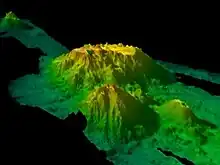
Seamount chains and hotspots
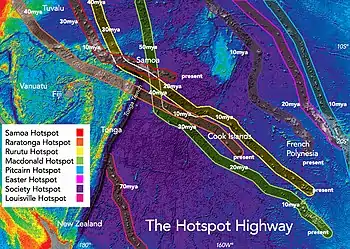
The Pacific Ocean contains several long seamount chains, formed by hotspot volcanism. These include the Hawaiian–Emperor seamount chain, the Tasmantid Seamount Chain, the Lord Howe Seamount Chain and the Louisville Ridge.
- Arago hotspot
- Bowie hotspot
- Cobb hotspot
- Easter hotspot
- Galápagos hotspot
- Hawaii hotspot
- Juan Fernández hotspot
- Lamont seamount chain
- Louisville hotspot
- Macdonald hotspot
- Marquesas hotspot
- Ngatemato seamounts
- Pitcairn hotspot
- Rarotonga hotspot
- Samoa hotspot
- Tarava Seamounts
- Tasmantid hotspot
- Taukina seamounts
- Ujlān volcanic complex
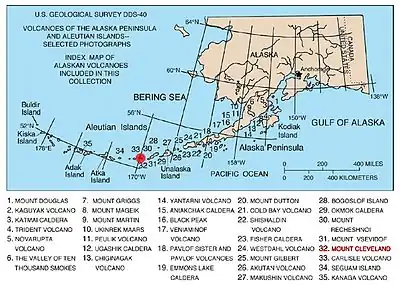
Arcs and belts
Faults and fracture zones
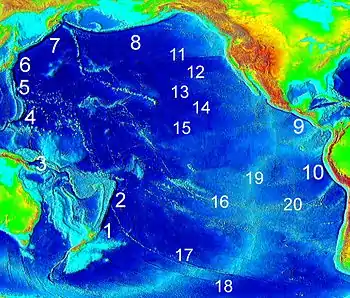
1. Kermadec
2. Tonga
3. Bougainville
4. Mariana
5. Izu–Ogasawara
6. Japan
7. Kuril–Kamchatka
8. Aleutian
9. Middle America
10. Peru–Chile
Fracture zones:
11. Mendocino
12. Murray
13. Molokai
14. Clarion
15. Clipperton
16. Challenger
17. Eltanin
18. Udintsev
19. East Pacific Rise (S-shaped)
20. Nazca Ridge
- Blanco Fracture Zone
- Clarton Fracture Zone
- Clipperton Fracture Zone
- Eltanin Fault System
- Macquarie Fault Zone
- Mendocino Fracture Zone
- Murray Fracture Zone
- Molucca Sea Collision Zone
- Queen Charlotte Fault
- Sorong Fault
Underwater ridges and plateaus
- Carnegie Ridge
- Chile Rise
- Darwin Rise
- East Pacific Rise
- East Tasman Plateau
- Explorer Ridge
- Galapagos Rise
- Gorda Ridge
- Hollister Ridge
- Juan de Fuca Ridge
- Juan Fernández Ridge
- Kula-Farallon Ridge
- Lord Howe Rise
- Magellan Rise
- Mid-Pacific Mountains
- Nazca Ridge
- Norfolk Ridge
- Pacific-Antarctic Ridge
- Pacific-Farallon Ridge
- Pacific-Kula Ridge
- Phoenix Ridge
- Shatsky Rise
- Tehuantepec Ridge
Trenches and troughs
Plates
Tectonic Plates associated with Pacific Ocean
|
- Amurian Plate
- Antarctic Plate
- Balmoral Reef Plate
- Banda Sea Plate
- Bird's Head Plate
- Caroline Plate
- Cocos Plate
- Conway Reef Plate
- Easter Plate
- Eurasian Plate
- Futuna Plate
- Galapagos Microplate
- Gorda Plate
- Halmahera Plate
- Indo-Australian Plate
- Juan de Fuca Plate
- Juan Fernández Plate
- Kermadec Plate
- Kula Plate
- Manus Plate
- Maoke Plate
- Mariana Plate
- Molucca Sea Plate
- Nazca Plate
- New Hebrides Plate
- Niuafo'ou Plate
- North American Plate
- North Bismarck Plate
- North Galapagos Microplate
- Okhotsk Plate
- Okinawa Plate
- Pacific Plate
- Philippine Sea Plate
- Rivera Plate
- Sangihe Plate
- Solomon Sea Plate
- South Bismarck Plate
- Sunda Plate
- Timor Plate
- Tonga Plate
- Woodlark Plate
- Yangtze Plate
Triple Junctions
The Pacific Ring of Fire
|
Volcanoes
- Alcedo Volcano
- Alofi Island
- Ball's Pyramid
- Bartolomé Island
- Clarion Island
- Daphne Major
- Eastern Gemini Seamount
- Futuna (Wallis and Futuna)
- Galápagos Islands
- Genovesa Island
- Hallasan
- Isabela Island (Galápagos)
- Isla Salas y Gómez
- Kilauea
- Lord Howe Island
- Maquinna
- Marchena Island
- Matthew and Hunter Islands
- Mauna Loa
- Mount Lidgbird
- Norfolk Island
- Nunivak Island
- Phillip Island (Norfolk Island)
- Pinta Island
- Poike
- Rábida Island
- Revillagigedo Islands
- Rocas Alijos
- San Benedicto Island
- Santiago Island (Galápagos)
- Sierra Negra (Galápagos)
- Socorro Island
- South Arch volcanic field
- Tamu Massif
- Volcán Wolf
References
Notes
- ↑ Neall & Trewick 2008, Abstract
- ↑ "Understanding plate motions". USGS. Retrieved 26 June 2013.
- ↑ "Plate Tectonics", Pacific Northwest Seismic Network. Retrieved 26 June 2013.
- ↑ Davaille & Romanowicz 2020, Introduction, pp. 2–5
- ↑ Waters, H. (February 2015). "Charles Darwin's Ocean Upwelling". Smithsonian Institution. Retrieved 7 March 2021.
- ↑ Boschman & Van Hinsbergen 2016, Abstract
- ↑ Boschman & Van Hinsbergen 2016, Introduction, pp 1–2
- ↑ Seton et al. 2012, Kula plate, pp. 231–232
- ↑ Seton et al. 2012, Phoenix plate, pp. 235–238
- ↑ Seton et al. 2012, Farallon Plate, pp. 227–231
- 1 2 Neall & Trewick 2008, Island origins, pp. 3295–3298
- ↑ van der Hilst & Seno 1993, Plate-tectonic reconstruction and the history of subduction, p 399
- ↑ Seton et al. 2012, Pacific Ocean and Panthalassa, p. 225
- ↑ Seton et al. 2012, Western Pacific and SE Asian back-arc basins, p. 248; SW Pacific Back-arc basins and marginal seas, pp. 248–250
- ↑ Gill 1984, p. 13
- ↑ Trent, D. D.; Hazlett, Richard; Bierman, Paul (2010). Geology and the Environment. Cengage Learning. p. 133. ISBN 978-0-538-73755-5.
- ↑ Sandell, Clayton (17 December 2009). "Deepest Undersea Volcanic Eruption Ever Seen". ABC News. Retrieved 26 June 2013.
- ↑ Amos, Jonathan (18 December 2009). "Deepest volcano caught on Pacific Ocean video – Amazing video has been obtained in the Pacific Ocean of the deepest undersea eruption ever recorded". BBC. Retrieved 26 June 2013.
- ↑ "2008 Oregon Offshore Earthquakes". NOAA. Retrieved 23 June 2013.
- ↑ Dziak, Robert P.; Fox, Christopher G. (1 December 1999). "The January 1998 Earthquake swarm at Axial Volcano, Juan de Fuca Ridge: Hydroacoustic evidence of seafloor volcanic activity". Geophysical Research Letters. 26 (23): 3429–3432. Bibcode:1999GeoRL..26.3429D. doi:10.1029/1999gl002332.
- ↑ Floyd, Mark (26 October 2009). "OSU researchers find cause of 2008 offshore earthquake swarms". Corvallis Gazette Times. Retrieved 26 June 2013.
- ↑ Lay, Thorne; Okal, Emile (1983). "The Gilbert Islands (Republic of Kiribati) earthquake swarm of 1981–1983" (PDF). Physics of the Earth and Planetary Interiors. 33 (4): 284–303. Bibcode:1983PEPI...33..284L. doi:10.1016/0031-9201(83)90046-8.
- ↑ Wetmiller, Robert J. (December 1971). "An earthquake swarm on the Queen Charlotte Islands Fracture Zone". Bulletin of the Seismological Society of America. 61 (6): 1489–1505.
Sources
- Boschman, L. M.; Van Hinsbergen, D. J. (2016). "On the enigmatic birth of the Pacific Plate within the Panthalassa Ocean". Science Advances. 2 (7): e1600022. Bibcode:2016SciA....2E0022B. doi:10.1126/sciadv.1600022. PMC 5919776. PMID 29713683.
- Davaille, A.; Romanowicz, B. (2020). "Deflating the LLSVPs: bundles of mantle thermochemical plumes rather than thick stagnant "piles"" (PDF). Tectonics. 39 (10): e2020TC006265. doi:10.1029/2020TC006265. Retrieved 7 July 2021.
- Gill, J. B. (1984). Orogenic andesites and plate tectonics (PDF). Springer. doi:10.1007/978-3-642-68012-0. Retrieved 10 July 2021.
- Neall, Vincent E.; Trewick, Steven A. (2008). "The age and origin of the Pacific islands: a geological overview". Philosophical Transactions of the Royal Society B. 363 (1508): 3293–3308. doi:10.1098/rstb.2008.0119. PMC 2607379. PMID 18768382.
- Seton, M.; Müller, R.D.; Zahirovic, S.; Gaina, C.; Torsvik, T.; Shephard, G.; Talsma, A.; Gurnis, M.; Maus, S.; Chandler, M. (2012). "Global continental and ocean basin reconstructions since 200Ma". Earth-Science Reviews. 113 (3): 212–270. Bibcode:2012ESRv..113..212S. doi:10.1016/j.earscirev.2012.03.002. Retrieved 23 October 2016.
- van der Hilst, R.; Seno, T. (1993). "Effects of relative plate motion on the deep structure and penetration depth of slabs below the Izu-Bonin and Mariana island arcs" (PDF). Earth and Planetary Science Letters. 120 (3–4): 395–407. Bibcode:1993E&PSL.120..395V. doi:10.1016/0012-821X(93)90253-6. hdl:1874/7652. Retrieved 7 March 2021.
